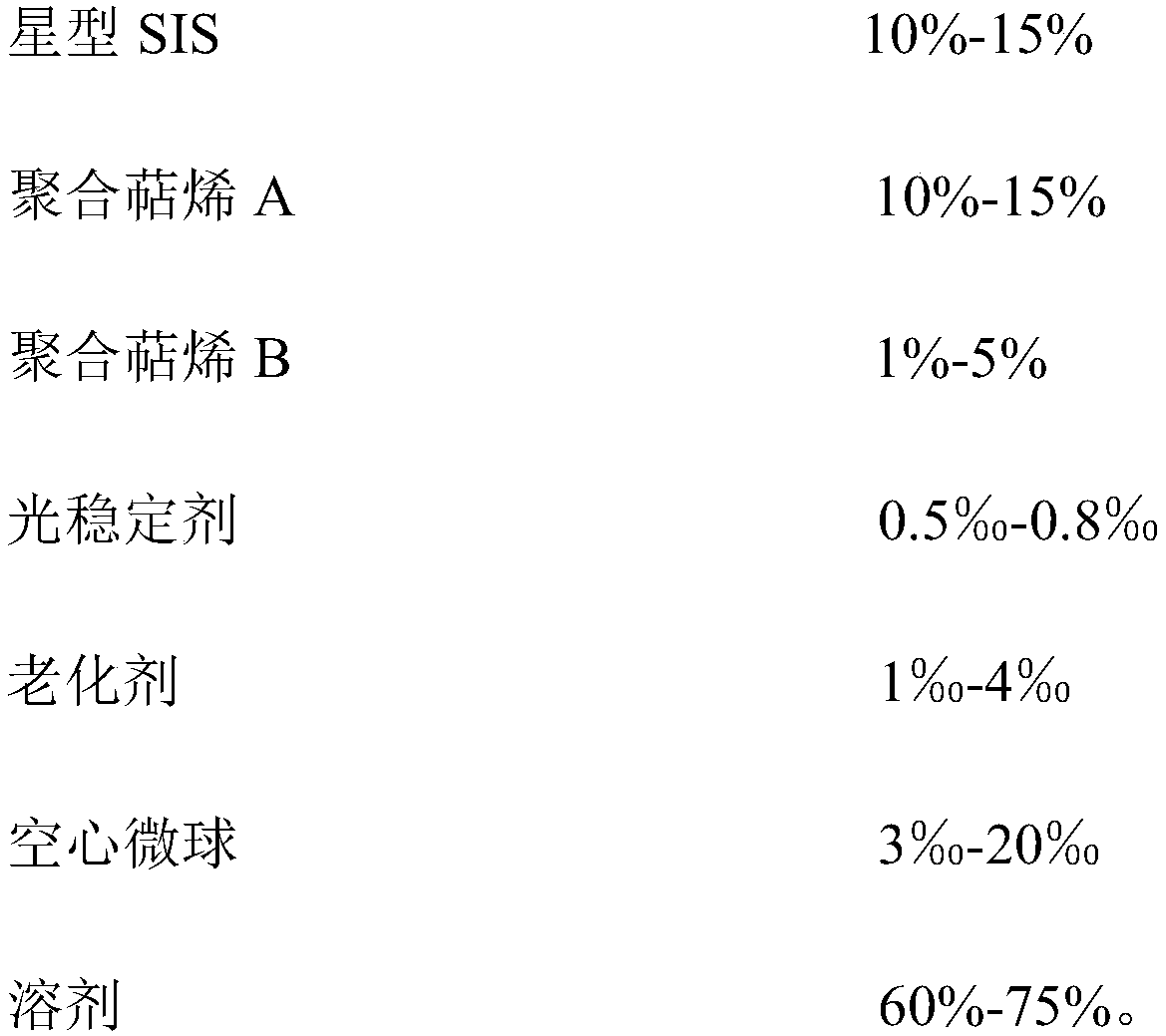UV photosensitive adhesive, UV protective film applying UV photosensitive adhesive for wafer and preparation method of UV protective film for wafer
A technology of photosensitive adhesives and adhesives, applied in the direction of adhesive additives, adhesives, non-polymer adhesive additives, etc., can solve the problem of inability to fully guarantee wafer adhesion, unstable performance of UV protective film, and inconvenient wafer processing technology and other problems, to achieve significant viscous reduction effect, soft glue, and improve yield and efficiency.
- Summary
- Abstract
- Description
- Claims
- Application Information
AI Technical Summary
Problems solved by technology
Method used
Image
Examples
Embodiment 1
[0026] A preparation method of a UV photosensitive adhesive in this embodiment: put 511g of 120# solvent oil into a 1000ml reaction bottle, then start the stirring device at a speed of 200rpm, and put in polymerized terpene A (softening point is 100°C) in turn while stirring. , melt viscosity is 500mPa s, molecular weight is 300, glass transition temperature is 50 ℃) 90g, polymerized terpene B (softening point is 105 ℃, melt viscosity is 50mPa s, molecular weight is 500, glass transition temperature (60°C) 25g, light stabilizer 2-hydroxy-4-methoxybenzophenone 0.5g, aging agent 1010 and 168 respectively 1.5g and 1g, stir for 15min and wait for it to dissolve, then put into star SIS (pull The tensile strength is 1500psi, the elongation at break is 800%, the Shore A hardness (10 seconds) is 30, and the relative density is 0.89g / cm 3 , the melt index is 6g, the styrene content is 15%, the diblock content is 0, and the weight-average molecular weight is 100,000) 100g, stir 6h to ma...
Embodiment 2
[0029] A preparation method of a UV photosensitive adhesive in this embodiment: put 516g of ethyl acetate into a 1000ml reaction bottle, then start the stirring device at a speed of 200rpm, and put in polymerized terpene A (softening point: 130°C, Melt viscosity is 1500mPa s, molecular weight is 1500, glass transition temperature is 110 ℃) 90g, polyterpene B (softening point is 105 ℃, melt viscosity is 50mPa s, molecular weight is 500, glass transition temperature is 60°C) 25g, light stabilizer 2-hydroxyl-4-n-octyloxybenzophenone 0.5g, aging agent 1010 and 168 respectively 1.5g and 1g, stir for 15min and wait for it to dissolve, then drop into star SIS (pull The tensile strength is 3000psi, the elongation at break is 1300%, the Shore A hardness (10 seconds) is 50, and the relative density is 0.92g / cm 3 , the melt index is 15g, the styrene content is 30%, the diblock content is 40%, and the weight average molecular weight is 500,000) 100g, stirred for 6h to make it completely d...
Embodiment 3
[0032] The preparation method of a kind of UV photosensitive adhesive of the present embodiment: drop into 521g of methyl isobutyl ketone in 1000ml reaction bottle, then start stirring device, rotating speed 200rpm, throw into polymerized terpene A (softening point is 120rpm) successively while stirring. ℃, melt viscosity is 1000mPa s, molecular weight is 1000, glass transition temperature is 100 ℃) 90g, polymerized terpene B (softening point is 95 ℃, melt viscosity is 40mPa s, molecular weight is 300, glass transition temperature The temperature is 40°C) 25g, light stabilizer 2-[4-[(2-hydroxy-3-dodecylpropyl)oxy]-2-hydroxyphenyl]-4,6-bis(2,4- Dimethylphenyl)-1,3,5-triazine 0.5g, aging agents 1010 and 168 respectively 1.5g and 1g, stirred for 15min until they were dissolved, then put into star SIS (tensile strength 2000psi, elongation at break The elongation rate is 1000%, the Shore A hardness (10 seconds) is 40, and the relative density is 0.90g / cm 3 , the melt index is 12g,...
PUM
| Property | Measurement | Unit |
|---|---|---|
| tensile strength | aaaaa | aaaaa |
| density | aaaaa | aaaaa |
| softening point | aaaaa | aaaaa |
Abstract
Description
Claims
Application Information
 Login to View More
Login to View More - Generate Ideas
- Intellectual Property
- Life Sciences
- Materials
- Tech Scout
- Unparalleled Data Quality
- Higher Quality Content
- 60% Fewer Hallucinations
Browse by: Latest US Patents, China's latest patents, Technical Efficacy Thesaurus, Application Domain, Technology Topic, Popular Technical Reports.
© 2025 PatSnap. All rights reserved.Legal|Privacy policy|Modern Slavery Act Transparency Statement|Sitemap|About US| Contact US: help@patsnap.com



